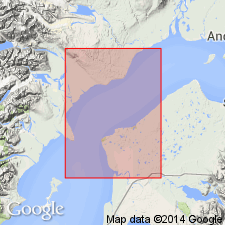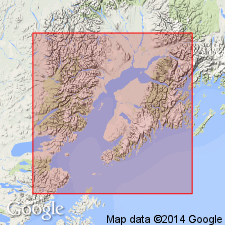
- Usage in publication:
-
- Sterling Formation
- Modifications:
-
- Named
- Dominant lithology:
-
- Sandstone
- Claystone
- AAPG geologic province:
-
- Alaska Southern region
Summary:
Named as uppermost formation of 5 of Kenai Group. Type section designated as subsurface exposures in Union Oil Company Sterling Unit No.23-15, NE1/4 SW/4 sec.15 T15N R10W, Seward Meridian, Cook Inlet Basin, south-central AK. Composed of gray massive sandstones, conglomeratic sandstones, and interbedded claystone. Is 1400 m thick. Unconformably overlies Beluga Formation (new). Unconformably underlies Pleistocene gravels. Outcrops in bluffs along western margin of Kenai Peninsula from Clam Gulch southward to beyond Ninilchik have been dated as Clamgulchian by Wolfe and others (1966) who suggest rocks are probably of Pliocene age, although they "could range from late Miocene to early Pleistocene" age.
Source: GNU records (USGS DDS-6; Menlo GNULEX).

- Usage in publication:
-
- Sterling Formation*
- Modifications:
-
- Age modified
- AAPG geologic province:
-
- Alaska Southern region
Summary:
Age is late Miocene and Pliocene based on Clamgulchian flora from Sterling Formation.
Source: GNU records (USGS DDS-6; Menlo GNULEX).

- Usage in publication:
-
- Sterling Formation*
- Modifications:
-
- Geochronologic dating
- AAPG geologic province:
-
- Alaska Southern region
Summary:
Clamgulchian type section samples range in K-Ar age on plagioclase from 8.1 +/-0.7 to 4.2 +/-1.4 Ma. Zircon fission-track ages range from 7.6 +/-0.7 to 4.9 +/-0.8 Ma. Samples are from west side of Kenai Peninsula (from Sterling Formation of Kenai Group).
Source: GNU records (USGS DDS-6; Menlo GNULEX).

- Usage in publication:
-
- Sterling Formation*
- Modifications:
-
- Age modified
- Biostratigraphic dating
- AAPG geologic province:
-
- Alaska Southern region
Summary:
Age is late Miocene and Pliocene based on Clamgulchian plant fossils.
Source: GNU records (USGS DDS-6; Menlo GNULEX).
For more information, please contact Nancy Stamm, Geologic Names Committee Secretary.
Asterisk (*) indicates published by U.S. Geological Survey authors.
"No current usage" (†) implies that a name has been abandoned or has fallen into disuse. Former usage and, if known, replacement name given in parentheses ( ).
Slash (/) indicates name conflicts with nomenclatural guidelines (CSN, 1933; ACSN, 1961, 1970; NACSN, 1983, 2005, 2021). May be explained within brackets ([ ]).

